Overview of diseases and pests of apricot
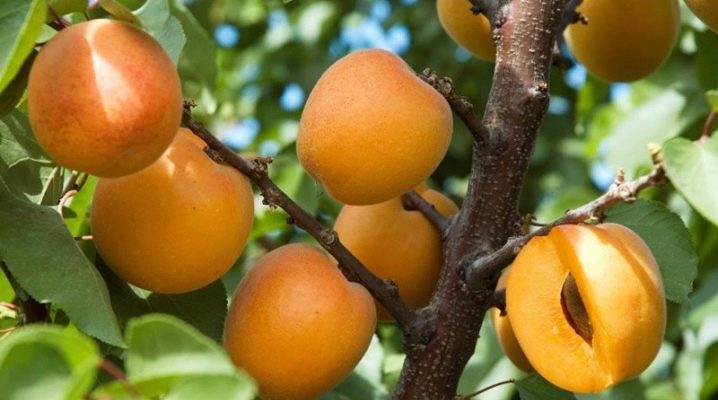
Apricot is a fairly common fruit tree. The plant is distinguished by good yield and unpretentious care. But, like other trees and shrubs, it often suffers from various diseases and pest attacks.
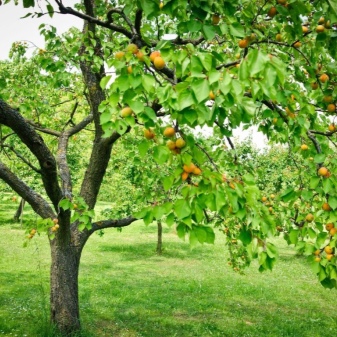
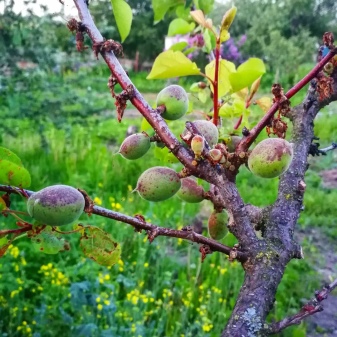
Treatment of diseases
For apricot, both viral and fungal diseases are dangerous.
Moniliosis
This disease is considered one of the most dangerous. It can destroy even a strong adult tree in a short time. To prevent this from happening, you need to study the description of this disease and, at the first signs, begin to fight it. In this case, the plant can still be saved. When a disease affects a tree, its foliage is the first to suffer. It becomes dry and brown. Further, the disease affects the fruits: the apricots begin to rot and fall to the ground, not having time to ripen. The bark of the trunk is covered with voluminous gray growths.
As a rule, the disease affects trees during the period of prolonged rains. To protect the plants, it is recommended to treat them with copper sulfate in the summer. The crown of the tree and its bark should be sprayed with a spray bottle. This is best done in the late evening or early morning.
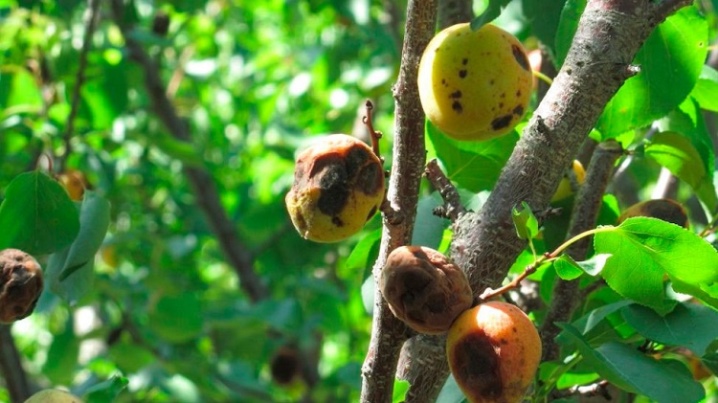
Monilial burn
This disease is one of the varieties of moniliosis. This disease got its name due to the fact that the foliage of an infected tree from the side seems to be burnt. It dries up and falls off in a short time. The disease also poses a danger to the fetus. If you do not start fighting it in time, the crop can be completely destroyed. Copper sulfate is also used to protect the plant from this disease. The solution needs to be treated not only on the branches and trunk, but also on the ground next to the tree.
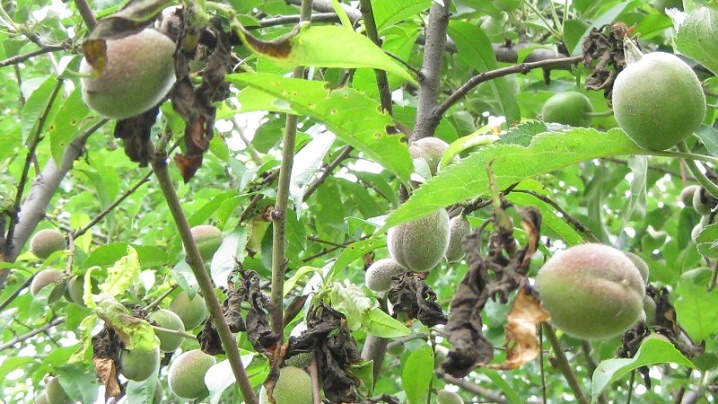
Fruit gray rot
Fungal disease affects apricot fruits, so it is a serious threat to ripe berries. If you do not start treating fruit rot in time, the disease can completely destroy the crop. You need to fight this disease very quickly, using all available means.
The first step is to remove all damaged parts from the tree. It is recommended to destroy shoots and fruits. After that, the tree and the soil next to it must be treated with a solution of copper sulfate. In order to prevent the infection of apricot with this disease, in autumn and spring it must be sprayed with "Nitrafen" or other similar preparations.

Brown leaf spot
This disease spreads most rapidly in warm and rainy weather. It is quite easy to notice that an apricot is sick. Dark yellow spots will appear on the foliage. Over time, they will begin to darken. Due to the development of the disease, the apricot weakens and does not bear fruit.
For prevention, trees in the spring need to be treated with a Bordeaux mixture. In the future, the apricot needs to be inspected from time to time. If you notice a small amount of dark spots on the foliage, the infected branches should be removed. There is no point in treating plants with other drugs.

Curl
This disease affects many fruit trees in the garden. Apricots are no exception. This disease manifests itself at the very beginning of spring. Young green foliage deforms very quickly and turns gray-green. Over time, the leaves begin to fall off. The diseased tree does not bear fruit.
To prevent the development of the disease, you need to remove the infected parts of the plant, barely noticing that the leaves are curling. For the prevention of disease, apricots are also recommended to be treated with a solution of copper sulfate. This should be done in early spring.
If possible, plants should also be sprayed with preparations containing mancozeb.
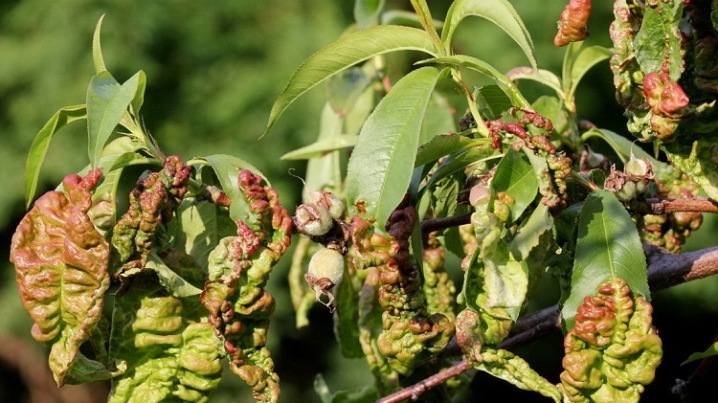
Hole spot
A disease called clasterosporia poses a particular danger to young trees. The first signs of its spread are dark reddish spots. They appear on young foliage and over time become covered with a hard crust. If you do not take any measures in a timely manner, small holes will appear in the place of the crusts later. This happens very quickly.
If foliage with small holes appears on the tree, it means that other parts of the plant will soon be affected. After a while, dark spots form on the fruits. The branches of the plants are covered with a reddish-purple bloom. Over time, small wounds appear in the place of these dark spots, from which gum flows. You need to deal with the perforated spot quickly. All affected parts of the tree must be trimmed and burned immediately. Sections are required to be processed with copper sulfate and garden var.
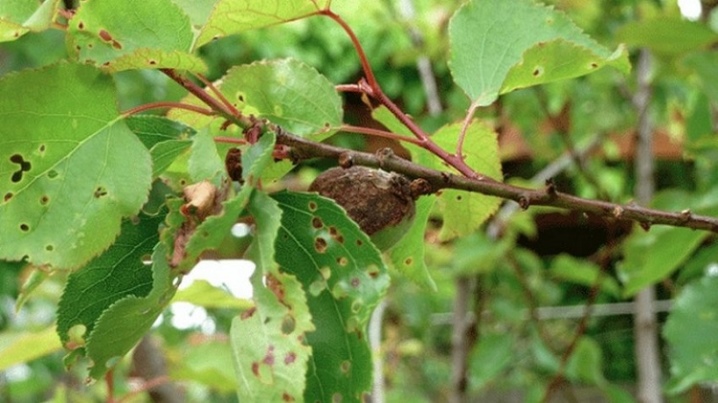
Stone scab
This fungal disease spreads especially quickly in thickened plantings. Dark spots appear on the foliage. Over time, it deforms and falls off. If you do not stop the development of the disease, it will spread to the fruit. An unpleasant gray coating will appear on them. In the future, such fruits burst, and their tender pulp rots.
To prevent the development of the disease, fallen leaves must be removed regularly. It is in it that this dangerous fungus usually hibernates. Do not water the trees too often. Excess moisture in the soil often becomes one of the main reasons for the development of diseases. In spring and autumn, the area with trees is also recommended to be treated with fungicides. To do this, you can use such an inexpensive and effective drug as "Captan-50".

Fusarium drying
At the very beginning of spring, apricots are also often affected by fusarium drying. The foliage of a diseased tree becomes dull and rough. Small dark spots form on its surface. The bark cracks very often.
Typically, this disease affects weak trees. To avoid infection, the plant needs to be fed regularly and closely monitor its condition. All cuts or cracks must be covered with garden varnish.
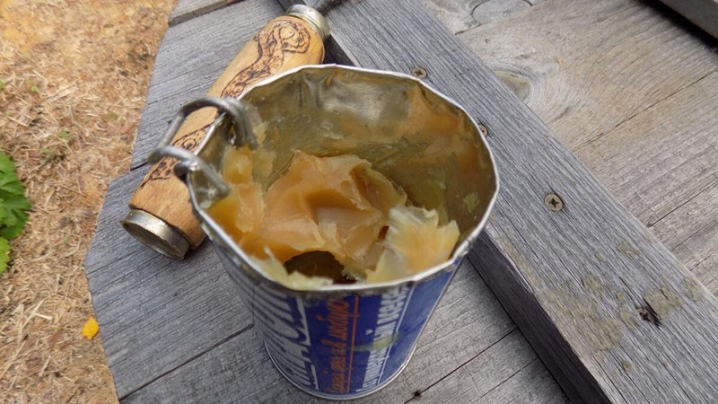
Cytosporous desiccation
This disease is also known as cytosporosis. It affects many fruit trees. But it poses the greatest danger to apricots and peaches. The affected areas are covered with reddish-brown spots. Over time, small black tubercles form on the bark. The sick apricot dies pretty quickly.
To protect the plant, its crown must be regularly trimmed, removing all dry and weak shoots. Spring spraying with Bordeaux mixture also helps many gardeners.
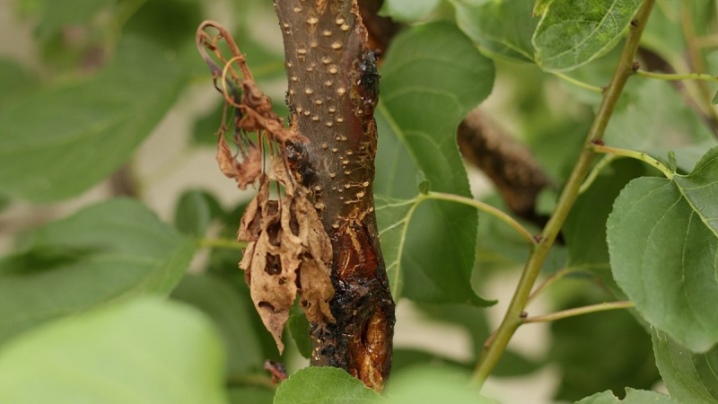
Verticillary wilting
This disease affects young plants at the very beginning of summer. Shoots and foliage are the first to suffer. Dull yellow spots appear on apricot leaves. Immediately after that, they begin to fall off. In the future, the plant begins to slowly die. It does not bear fruit and remains stunted for a long time. In order to prevent the death of the plant, all infected shoots must be immediately removed and destroyed.
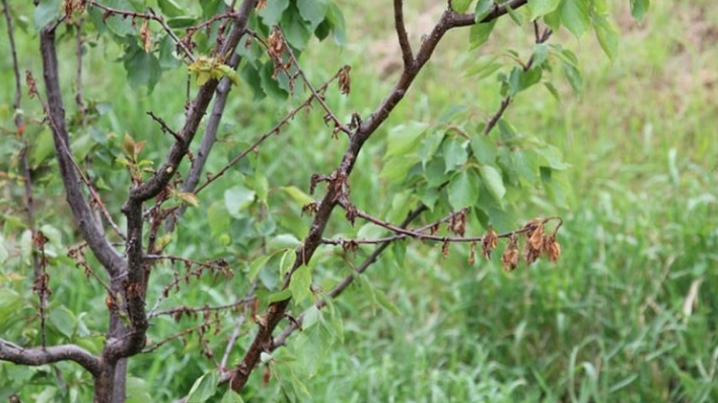
Gum therapy
If a tree secretes resin from wounds and cracks, the gardener should be alert. Gum removal is a sign that the apricot is weakened. Having found cracks on the barrel, the gum must be removed from its surface. The same must be done with the affected tissues. After that, it is recommended to treat the affected area with a solution of copper sulfate. This is best done in the evening. This procedure should be repeated several nights in a row.
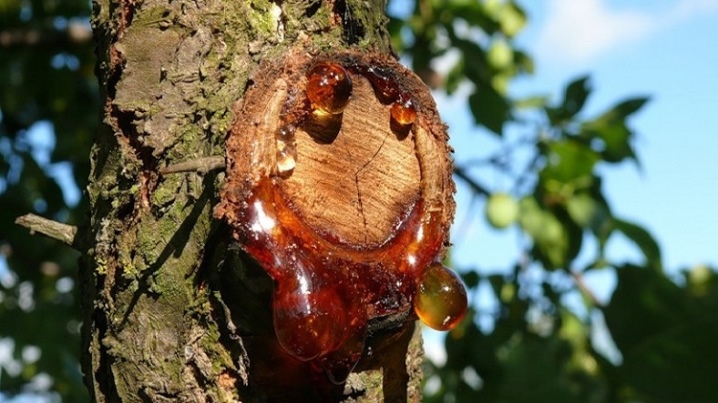
Pest control
The danger for apricot trees is not only diseases, but also various pests. Most often, plants suffer from insect attacks.
- Aphid. This is one of the most common pests. Apricot infected with green aphids changes slightly in appearance. Its foliage curls, and the shoots bend. Small pests can be seen on the back of healthy leaves. Plants affected by disease become more susceptible to various diseases. If there are not too many pests on the site, you can use folk methods to combat them. The crown is treated with soapy water, infusion of marigolds, tobacco or onions. These products can be applied both before and after flowering. If there are a lot of pests on the site, it is better to use insecticides to treat the crown. The most popular options are Fufanon and Karbofos. You can spray your trees with them only before the beginning of fruiting of apricots.
- Weevil. This pest settles not only on apricots, but also on other trees that produce tasty fruits. Fruit weevils are omnivorous. They eat not only foliage, but also buds with fruits. To protect the site from these insects, the trees must be pruned regularly. It is also important to remove all plant debris from the area.
- Hawthorn. The caterpillars of these butterflies pose a danger to apricots. They eat up the foliage and buds of young trees in a short time. There is no point in using insecticides to combat these pests. They are usually harvested by hand. Some gardeners also use soapy water to control butterflies. After processing the site with such a product, the pests quickly leave it.
- Fruit moth. At the very beginning of summer, butterflies lay eggs in the foliage, ovaries, leave them on the leaf stalks. This leads to the fact that they begin to crumble. In addition, pests can settle under the bark of apricot, climbing into cracks. It also harms mature plants. To prevent pests from settling on a tree, it is recommended to process it with an infusion of needles, tobacco or tansy. Noticing moth caterpillars on the apricot, you also need to get rid of them. Usually gardeners just brush them off gently. Trapping belts can also be used instead. If there are a lot of caterpillars on the site, the trees should be treated with insecticides.
- Black goldfish. Both beetles and small larvae are dangerous for an adult apricot. The first ones affect young shoots and foliage, the second ones - the root system. To protect the site from pests, it is recommended to dig up the soil next to the tree in autumn and spring. At the same time, plants can also be treated with insecticides or folk remedies with a pungent aroma.
Rodents are also dangerous. If there are rats or mice on the site, it is worth spreading the poison or placing traps next to the tree. Very often, these pests severely injure trees. If the bark is not very badly damaged, the tree should be wrapped with stretch wrap or electrical tape. Sorrel sheets are usually placed under it. In the fall, these bandages are removed.
If the trunk of the plant has been damaged too much, it is better to cut the tree down. If the gardener is lucky, green growth will appear next to the stump over time. It can be used to propagate apricots.
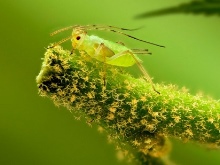
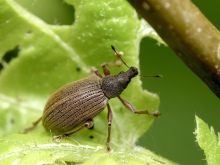
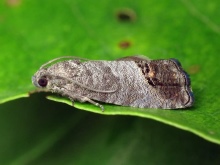
Prevention measures
To spend less time on pest and disease control, plants need to be properly cared for. It is worth paying attention to the agrotechnical measures listed below.
- Watering and feeding. Regular watering of the plants, as well as timely fertilization, helps to make the plants healthier and stronger.
- Pruning. This procedure should also be performed regularly. If the crown of the tree is thick and sloppy, small pests will more often settle there. In addition, such a plant will be susceptible to various diseases.In order to prevent trees from becoming infected, garden tools must be treated with antiseptics, and the cuts must be treated with garden varnish.
- Whitewash. The tree trunk must be whitewashed regularly. This is done both in spring and autumn. For the treatment of the plant, a conventional lime solution is used. Sometimes copper sulfate or yellow clay is added to it.
- Loosening and digging up the soil. These procedures help get rid of pest larvae that often hibernate in the soil.
If you water, spray and prune trees in a timely manner, they will be healthy and beautiful. In addition, it should be noted that timely processing of plants in spring and autumn increases the yield of apricots.

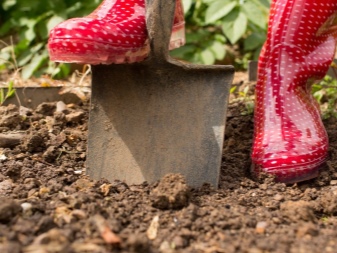
The most resistant varieties
For planting on the site, it is also recommended to choose apricot varieties that are resistant to diseases and vigorous activity of pests.
- Big Red. This plant is medium-sized. Its crown is thick and spreading, and the fruits are bright red. They stick well to wood and have a pleasant sweet taste. In addition to disease resistance, this variety also pleases gardeners with its winter hardiness.
- "Wondercot". This apricot variety is early. The tree develops very quickly and has a good yield. His fruits are delicious. They are distinguished by their yellow-orange color and rounded shape.
- Spring Blanche. These apricots also begin to bear fruit quite early. The fruits are bright orange, they have a slightly oblong shape. Their flesh is dense, but juicy.
- "Prizia". This is another very early variety. Trees begin to bear fruit in the first half of June. The fruits of such an apricot are very tasty and juicy. They can be eaten fresh or used to make delicious jams.
- Banzai. This French variety is also an early one. The trees begin to bear fruit in June. The fruits that appear on the branches are distinguished by a bright orange color and a pleasant aroma.
All of these varieties are great for planting in both warm and cold regions of the country. Proper care and timely processing of trees help protect the site from pests and diseases, as well as increase plant productivity.
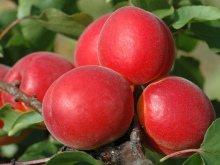
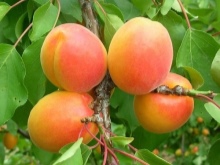
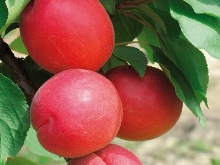









The comment was sent successfully.